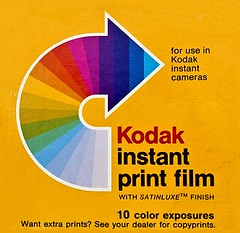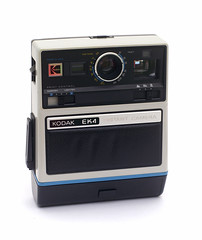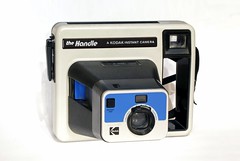Kodak Instant

|
| Satinluxe instant film image by Kenneth Dwain Harrelson (Image rights) |
From 1963 to 1969, Kodak manufactured Polaroid's instant film components before Polaroid decided to produce their own. After this Kodak thought to create similar peel-apart instant packfilm, given their experience manufacturing Polaroid's film. There were many prototypes and test runs of the film with many private demonstrations to their board. Plans changed when Polaroid in 1972 released the integral type film with the introduction of the SX-70 system. Kodak decided to scrap the plans for packfilm release and focus on an integral type process. Kodak continued to use highly modified versions of Polaroid packfilm cameras as prototypes to test their integral products.
A few years later Kodak introduced its own instant film products in 1976, which were different from Polaroid's in several ways. Kodak instant film was exposed from the back without a mirror, the opposite of Polaroid's film which was exposed from the front with a mirror to reverse the image. This has several advantages: first the instant film is much less complicated compared to Polaroids which has the front layer that has to be transparent during exposure, opaque after the chemical spread and transparent after a development time. Kodak's method uses the chemical reagent as a light shield during development. The instant film in this process is capable of higher resolution compared to Polaroid's system since light does not have to travel as many layers to reach the negative. Other advantages include being able to use a matte finish on the face of the photo. The release of the higher ISO Trimprint series of instant products in the early 1980 also made it easy to remove the instant photo from the development pod. Without a mirror the camera are not as complex and less expensive to produce. The film path being much simpler also allow the use of a simple mechanical crank to spread and eject the film print instead of a electronic motorized unit in Polaroids.
On the other side of the pacific, Fujifilm also wanted an instant photo system. Though not identical, Fuji adopted instant film technology like Kodak's. For more see Fujifilm instant photography.
Unlike Polaroid's integral film packs, Kodak's did not contain a battery, along with conventional batteries, the use of a flat J sized 4LR61 batteries were also common in the cameras. This decision was made because it would cost less per pack and because Polaroid had a long history of technical problems with batteries in film packs which led to them manufacturing their own.
Upon introduction of Kodak instant products, Polaroid filed suit against Kodak in 1976 for patent infringement. The case dragged on for years. Kodak lost the dispute, and after the ruling in 1985, Kodak announced the discontinuation of their instant photo products.
Cameras
| ||
|
Kodak Instant PR10/PR144
(1978)
|
Kodamatic Trimprint HS144
|
Film
The original Kodak Instant line of cameras uses a ISO 150 instant film. They came in 10 photos per pack. The main version PR10 has a glossy surface, while a variation called "Satinluxe" has a silky matte type finish. Upon release of the 300 ISO Kodamatic Instant system the PR10 was replaced with the PR144, stating compatibility differences.
Kodak Instant ISO 150 film
- PR10
- PR10 Satinluxe a matte finish film
- PR144-10 (replaced PR10)
Kodamatic Instant ISO 300
- HS144-10 Trimprint
- AVS 144-10 Instagraphic slide film
- AVP 144-10 Instagraphic print film
- ID 144-10 -2 Readyprint ID system
Alternative Kodak instant film
While Kodak instant films have been discontinued, Fuji's instant film for the Fotorama system had been available in Japan since the 1980s and is very similar to Kodak's. The pictures are the same size, the cartridge is almost the same, with some easy plastic modifications; the Fuji Fotorama FI-10 series films can be made to fit. It was closest to the Kodak with the ISO at 160, if required many of the camera's brightness controls can be adjusted to work with the different ISO; However, the FI-10 films was discontinued in the 1990s. The faster ISO 800 instant films from the System 800 and instant ACE will work as well but would require the use of a filter either on the film cartridge or lens. While the ACE film will require the additional step of transferring of the picture elements into a compatible Kodak or modified Fuji 800 cartridge pack. In 2010, Fujifilm discontinued both the System 800 as well as the Instant ACE film.
Links
- Kodak Instant picture cameras at Kodak Classics
- Instant camera settlement FAQ (archived) at Kodak

